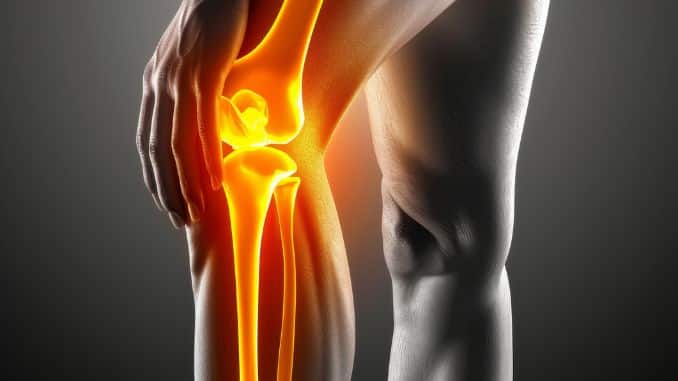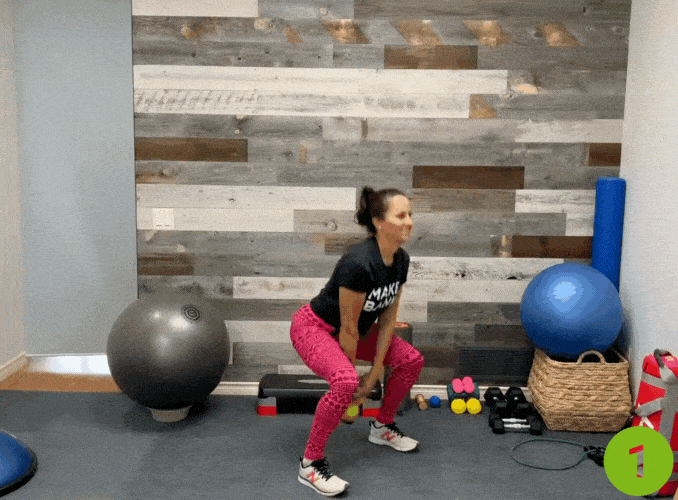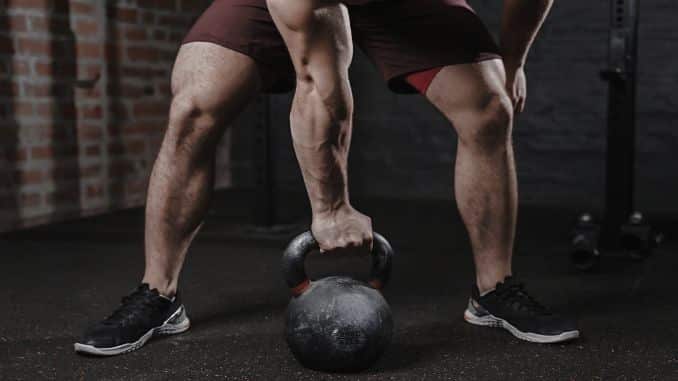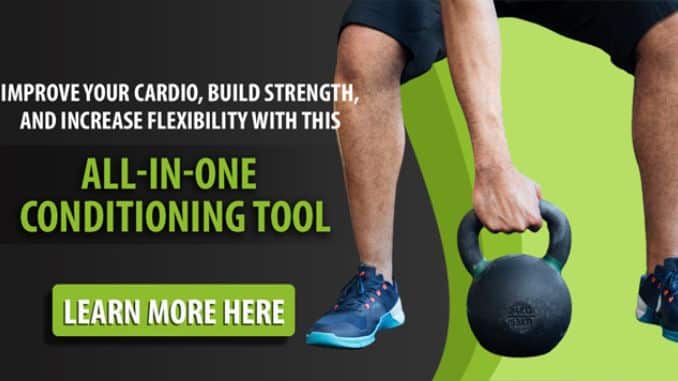Medical Disclaimer: The information in this blog is for enlightening and educational purposes only and is not intended as medical advice. The content in this post is not meant to substitute for a professional medical diagnosis, advice, or treatment. Always ask advice from your physician or other qualified health providers with any questions you may have regarding a medical condition.
Knee pain [1] can make even simple movements unbearable, but what if the key to relief was found in kettlebell exercises?
In fact, knee pain ranked as the primary joint complaint according to a recent survey, highlighting the need for effective solutions.
Strengthening your knee joint isn’t just about addressing knee pain—it’s about improving hip and knee strength, maintaining pelvic motion, and ensuring functional movement.
Let’s dive into the best kettlebell exercises for knee pain and how they help treat knee pain effectively.
Understanding Knee Pain and the Knee Joint

Knee pain is a common complaint that affects millions of people worldwide. The knee joint is a complex structure that consists of bones, ligaments, tendons, and cartilage. It is responsible for bearing the body’s weight and facilitating movement. However, when the knee joint is subjected to excessive stress, injury, or wear and tear, it can lead to knee pain.
The knee joint is composed of three bones: the femur (thigh bone), tibia (shin bone), and patella (kneecap). The joint is surrounded by ligaments, tendons, and cartilage that provide stability, flexibility, and support. The knee joint has various movements, including flexion (bending), extension (straightening), and medial-lateral rotation.
Knee pain can be caused by a variety of factors, including overuse, injury, arthritis, and poor biomechanics. Pain can also be referred from other areas, such as the hip or ankle. Understanding the knee joint and its functions is essential for addressing knee pain and developing effective treatment strategies.
Step-by-Step Kettlebell Exercises for Knee Pain Relief
1. Kettlebell Swing

- Begin in an upright standing position with your feet wider than shoulder-width apart, maintaining good alignment with your head, shoulders, and hips.
- Hold a small kettlebell with both hands.
- Engage your core. Inhale and hinge through your hips, engaging in hip flexion, and bend both knees into a squat position to bring the kettlebell between your legs.
- Keep your spine neutral. Then, exhale and push your hips forward to lift your body into a standing position.
- Allow your arms to swing the kettlebell as far as it naturally goes or ideally at shoulder level.
- Lower your body to return to the starting position and repeat the movement with 10 repetitions.
2. Kettlebell Plank Drag
- Begin in a straight arm plank position on the floor with your arms beneath your shoulders and your feet wider than hip distance to form a stable base.
- Maintain good alignment with your head, shoulders, hips, and toes.
- Place a small kettlebell just behind your right arm.
- Engage your core. Reach your left arm across your chest to grab and drag the kettlebell under your body towards the left side.
- Repeat the movement using your left arm.
- Alternately repeat the sequence of movements with 10 repetitions.
- This exercise also aids in external rotator muscle strengthening, which is crucial for hip stability and knee pain relief.
3. Kettlebell Squat and Press
- Begin in an upright standing position with your feet shoulder-width apart, maintaining good alignment with your head, shoulders, hips, and legs.
- Hold a small kettlebell with both hands. Engage your core. Inhale and hinge through your hips, and bend both knees into a squat position to bring the kettlebell to your chest level.
- Keep your spine neutral. Then, exhale and push your hips forward to lift your body into a standing position as you extend and press your arms forward at shoulder height.
- Lower your body to return to the starting position and repeat the movement with 10 repetitions.
4. Kettlebell Single Leg Arm Press
- Begin in an upright standing position with your feet hip-width apart, maintaining good alignment with your head, shoulders, hips, and legs.
- Hold a small kettlebell with your left hand.
- Bend your left elbow to bring the kettlebell to shoulder height.
- Engage your core. Bend your left knee to bring all your weight to your right leg, engaging your hip abductor, then lift your left arm overhead.
- Hold the position for a couple of seconds.
- Lower your hand and leg down and repeat the movement with 10 repetitions.
- Relax and repeat the movement on the opposite side.
Why Do Strong Knee Joints Matter?

The knee is a primary joint that endures stress forces from repetitive squatting motions, sudden downward force, and improper lifting limb techniques.
Research suggests that hip strengthening prior to focusing on the knee can lead to quicker pain relief, especially for conditions like patellofemoral pain syndrome.
Weakness in the hip muscles, external rotator muscle, and quadriceps can lead to conditions like patellofemoral pain syndrome. Strengthening the knee joint with functional therapeutic exercise relieves pain and improves knee position in everyday movements.
Functional Kettlebell Training for Knee Pain
Kettlebell exercises aren’t just for strength training—they’re functional exercises that encourage, improve spinal posture, and control posture during movements.
Dr. Ben Fung, PT, DPT, Functional kettlebell training [3] can be an effective approach to alleviate knee pain by focusing on hip-strengthening exercises. Strengthening the hip abductors and external rotators plays a crucial role in reducing knee discomfort. Incorporating kettlebell movements like side swings and single-leg deadlifts can enhance hip stability and control, thereby decreasing stress on the knee joint.
Tips for Avoiding Knee Pain with Kettlebell Exercises

Kettlebell exercises can be an effective way to improve hip and knee strength, as well as address knee pain. However, it is essential to use proper form and technique to avoid knee pain.
Here are some tips for avoiding knee pain with kettlebell exercises:
- Use proper form and technique: Make sure to use proper form and technique when performing kettlebell exercises. This will help to reduce the risk of injury and knee pain.
- Start with light weights: Start with light weights and gradually increase the weight as you become stronger. This will help to reduce the risk of injury and knee pain.
- Focus on hip and knee strength: Kettlebell exercises that target the hip and knee muscles, such as the Kettlebell Single Leg Arm Press, can help to improve hip and knee strength and reduce the risk of knee pain.
- Avoid overuse: Avoid overusing the knee joint by taking regular breaks and stretching and mobilizing the knee joint.
- Use proper footwear: Wear proper footwear that provides support and stability for the knee joint.
By following these tips, you can help to avoid knee pain and improve hip and knee strength with kettlebell exercises.
Why Kettlebells Work for Hip and Knee Strength?

Kettlebell exercises for knee pain work by promoting adduction and internal rotation, strengthening the hip abductors, improving knee position, and reducing stress forces on the lower extremity.
Fitness expert Greg Brookes highlights that kettlebell swings are particularly beneficial for individuals with knee issues, as they provide a cardiovascular workout without requiring a full knee bend, thereby reducing strain on the knee joint.
Final Thoughts
Knee pain doesn’t have to limit your movement. Incorporating kettlebell exercises into your routine offers pain relief, strengthens knee joints, and promotes functional movement.
Whether it’s a single-leg deadlift, kettlebell swings [2], or stance limb control, therapeutic exercise is consistently encouraged by experts as an effective approach to knee rehabilitation. Try these exercises today and regain confidence in your knee strength!
Transform your knee health and build strength with kettlebell exercises! Start your journey to pain-free knees now and check out our 10 Compound Kettlebell Exercises for Increased Strength!
FAQ’s
Are kettlebells hard on the knees?
Not if used with proper form. Movements like squats and swings should be controlled, with knees aligned and weight evenly distributed to avoid strain.
Is a kettlebell good for arthritis?
Yes, when done correctly. Kettlebell training can improve joint mobility, strength, and circulation, but lighter weights and controlled movements are recommended.
Who should avoid kettlebell swings?
Those with severe back pain, herniated discs, poor hip mobility, or weak core stability should avoid swings or modify them under professional guidance.
Is it OK to use kettlebells every day?
It depends on intensity. Daily light to moderate workouts focusing on mobility and endurance are fine, but high-intensity training needs rest days to prevent overuse injuries.
What are the risks of kettlebell injuries?
Poor form, excessive weight, and lack of control can lead to back strain, wrist injuries, shoulder impingements, and knee stress. Proper technique is key to avoiding these risks.


